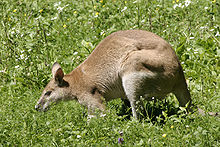Nimble Wallaby
| Nimble Wallaby | ||||||||||||
|---|---|---|---|---|---|---|---|---|---|---|---|---|

Nimble Wallaby ( Macropus agilis ) |
||||||||||||
| Systematics | ||||||||||||
|
||||||||||||
| Scientific name | ||||||||||||
| Macropus agilis | ||||||||||||
| ( Gould , 1842) |
The Agile Wallaby ( Macropus agilis ) is a Känguruart from the subgenus of the wallaby ( Notamacropus ). It is the largest wallaby and the only one found in New Guinea as well as Australia .
features
The fur of the agile wallabies is colored yellow-brown on the upper side, the underside is lighter. In addition, there are white stripes on the cheek and hip. As with most kangaroos, the hind legs are significantly longer and stronger than the front legs, the tail long and muscular, and the skull elongated. These animals reach a head body length of 60 to 105 centimeters, the tail can be up to 75 centimeters long. At around 20 kilograms, males are significantly heavier than females who reach around 12 kilograms.
distribution and habitat
Agile wallabies are common in northern Australia and New Guinea. In Australia, its range extends from northeastern Western Australia over the northern Northern Territory to northern and eastern Queensland . In New Guinea they inhabit the southern parts of the country and some offshore islands. They prefer open forests and grasslands as habitats , but are not very demanding in terms of their habitat.
Way of life
These kangaroos can often be seen in small groups of up to ten animals, but they have no social structures and are also not permanent, but there are also solitary animals. Like most kangaroos, they show no territorial behavior and are mainly nocturnal.
Nimble wallabies are herbivores that eat different plants depending on their habitat and season. In more humid areas they eat grass, leaves and fruits, in dry regions they also eat roots and other parts of plants.
Reproduction
Agile wallabies can reproduce year-round, but most births occur between May and August. After a gestation period of around 29 days, the female gives birth to a single young. This spends the first six to seven months continuously in the mother's pouch, after seven to eight months they leave it for good and are weaned at one year. Life expectancy in the wild can be up to ten years.
threat
In contrast to many smaller wallaby species, the numbers of agile wallabies have declined only slightly since the Europeans settled Australia. The IUCN lists them as not endangered. In some regions they have increased so much that they are considered a plague.
The only current stops in Europe are Munich, Berlin and Magdeburg.
supporting documents
literature
- Ronald M. Nowak: Mammals of the World . Johns Hopkins University Press, Baltimore 1999. ISBN 0-8018-5789-9
Web links
- For more information on Animal Diversity Web (English)
- Macropus agilis onthe IUCN Red List of Threatened Species . Retrieved May 12, 2009.


